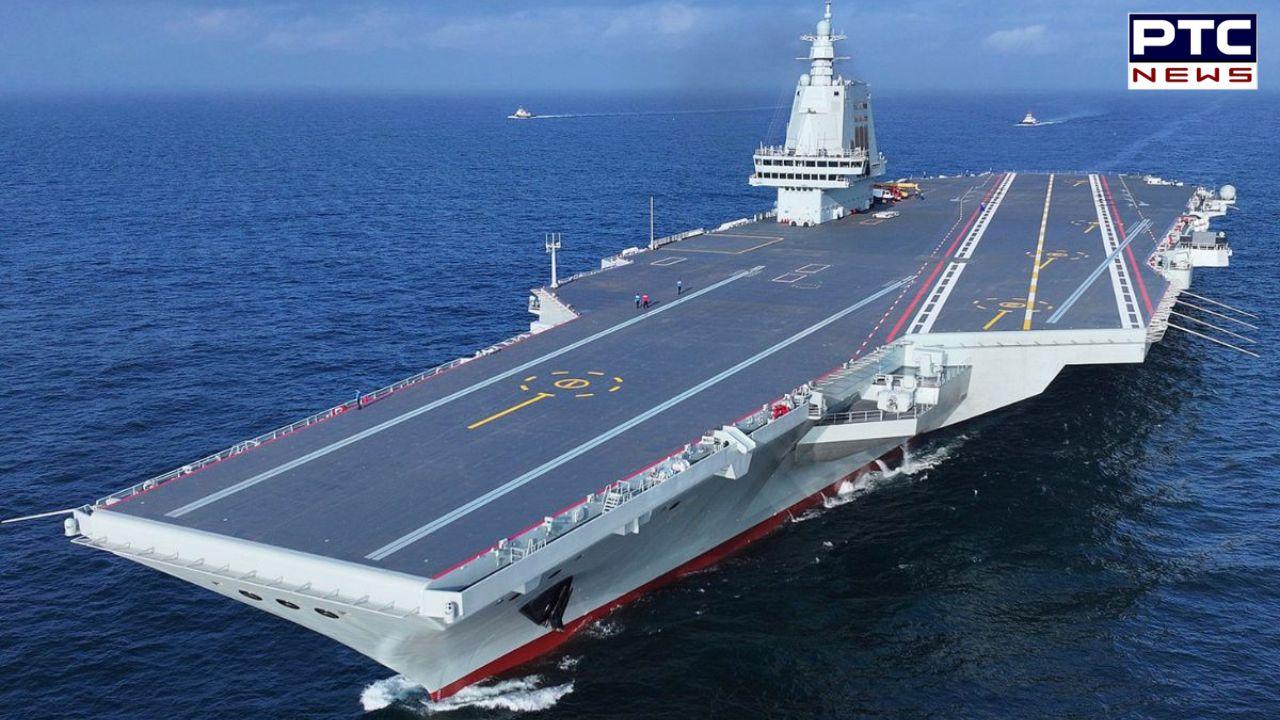- November 23, 2024
- Updated 5:24 am
India’s Navy may face new challenges with China’s new super-carrier
PTC News Desk: Following a brief sea testing, the 80,000-ton warship known as the Fujian, China’s first super-carrier on Friday, has returned to port. An important turning point in China’s military and naval capabilities has been reached with the construction of the aircraft carrier, the country’s most sophisticated vessel of its kind.
According to the reports, China’s first indigenous aircraft carrier design, the Fujian, or Type 003 class carrier, is the first to use electromagnetic catapults and an integrated propulsion system. The goal of the electromagnetic catapults, which will eventually replace the traditional steam-powered ones, is to launch airplanes from the deck of the Fujian with accuracy and dependability.

The only other military that has similar technology on its carriers is the US Navy, which is still regarded as the most technologically advanced Navy in the world.
It is now anticipated that the Fujian will shortly start carrier-borne aircraft trials, which might take up to a year before the battleship is fully declared operational.
China is working to improve its naval capabilities and project power, especially in the Indo-Pacific area, and this includes creating aircraft carriers.
Liaoning, China’s first aircraft carrier, was initially acquired from Ukraine in 1998. It was built during the Soviet era. The carrier was laying around at the time, unfinished. The People’s Liberation Army Navy (PLAN) commissioned it after it was refitted in 2012. Liaoning has mainly served as a training ground and a representation of China’s expanding military might.
In April 2017, the Shandong, the country’s second carrier and its first domestically built aircraft, was introduced for service in December 2019. The vessel, which is a greatly upgraded version of the Liaoning, has been used in operational deployments with the Shenyang J-15 “Flying Shark” fighter, a version of the Russian-built Sukhoi 33 fighter jet with notable Chinese upgrades.
In addition, the J-35, a carrier-borne stealth fighter anticipated to enter service in the future, is being developed by the Chinese Navy. The Fujian, China’s newest aircraft carrier, is intended to be the base of operations for the J-35.
INS Vikramaditya and INS Vikrant are the two aircraft carriers that the Indian Navy presently uses. For almost ten years, the Indian Navy has desired a bigger, more powerful aircraft carrier.
Building a carrier comparable to the Fujian would reportedly cost India $7 billion (around Rs. 56,000 crore). Adding new-build fighters to the fleet could add an additional $8 billion (about Rs 65,920 crore) to the cost.
Currently, the government is thinking of approving a smaller carrier that would be the same size as the INS Vikrant. Additionally, the government and Dassault of France are negotiating the purchase of 26 Rafale-M aircraft for the Vikrant, at an estimated cost of $8 billion (Rs 65,920 crore). The Vikrant’s older, less dependable MiG-29K aircraft, manufactured in Russia, would be replaced by the Rafale-M.
Nine nations will have frontline aircraft carriers in service as of May 2024. These nations are Russia, France, Spain, China, Italy, India, Japan, and the United States. With 11 carriers in operation, the United States has much more than any other nation.
Recent Posts
- Crown of goddess Kali, gifted by PM Modi, stolen from temple in Bangladesh
- Hezbollah leader survives assassination attempt amid Israeli strikes that kill 22 in Beirut
- ਕ੍ਰਿਕਟ ਦੇ ਬਦਲੇ ਨਿਯਮ, ਹੁਣ ਇਸ ਕੇਸ ‘ਚ ਦੁਬਾਰਾ ਨਹੀਂ ਮਿਲੇਗੀ ਬੈਟਿੰਗ, ਮੰਨਿਆ ਜਾਵੇਗਾ
- ਸਚਿਨ ਤੇਂਦੁਲਕਰ ਦੇ ਬਰਾਬਰ ਪਹੁੰਚੇ ਜੋ ਰੂਟ, ਪਰ ਵਿਰਾਟ ਦੇ ਇਸ ਰਿਕਾਰਡ ਤੋਂ ਅਜੇ ਵੀ ਦੂਰ
- Ratan tata death: ਸਿਰਫ ਵੋਲਟਾਸ ਹੀ ਨਹੀਂ, ਸਵੇਰ ਤੋਂ ਰਾਤ ਤੱਕ ਤੁਹਾਡਾ ਕੰਮ ਟਾਟਾ ਦੇ ਬਿਨਾਂ ਨਹੀਂ ਚੱਲ ਸਕਦਾ
